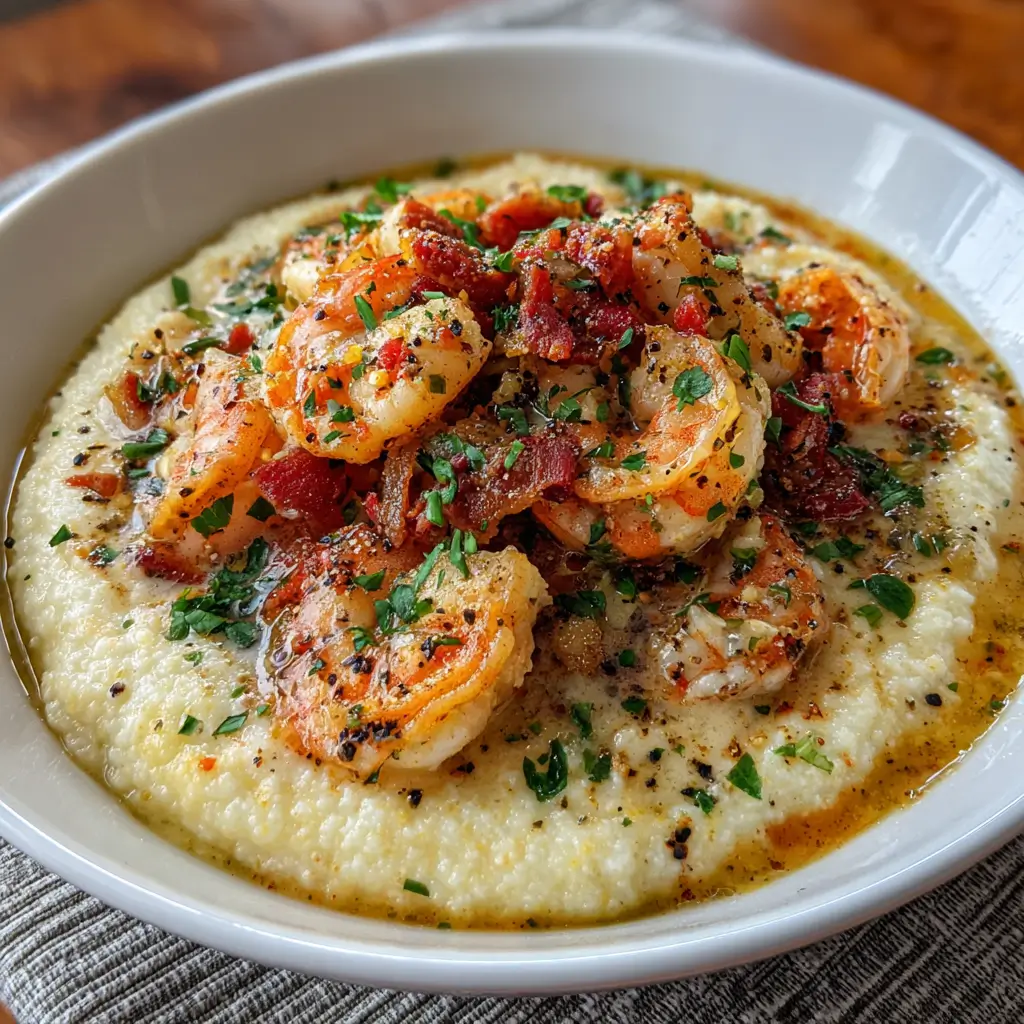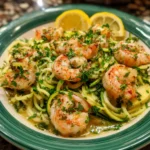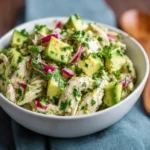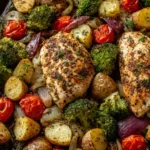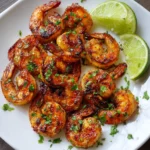Shrimp and Grits: A Southern Culinary Treasure
Introduction
Shrimp and grits is more than just a dish—it’s a story on a plate, a cultural emblem of the American South that has journeyed from humble coastal beginnings to gourmet restaurant menus across the nation. This beloved classic combines the creamy richness of stone-ground grits with the briny sweetness of fresh Gulf or Atlantic shrimp, creating a harmony of flavors that speaks to tradition, resourcefulness, and regional pride. Originally a staple among Lowcountry fishermen in South Carolina and Georgia, shrimp and grits has evolved into a culinary icon celebrated for its rustic charm and sophisticated potential.
Today, it’s not uncommon to find elevated versions of shrimp and grits featuring bacon lardons, wild mushrooms, smoked paprika, and even truffle oil in fine dining establishments. Yet at its heart, this dish remains deeply rooted in simplicity, comfort, and seasonality. Whether served as a hearty breakfast, a satisfying lunch, or an elegant dinner entrée, shrimp and grits continues to capture the imagination and appetite of food lovers everywhere. In this comprehensive guide, we’ll explore every aspect of this Southern masterpiece—from its storied past to modern-day interpretations—so you can master it in your own kitchen.
The History
The origins of shrimp and grits trace back centuries to the Gullah people of the South Carolina Lowcountry and the Sea Islands. The Gullah, descendants of enslaved West Africans, preserved their culinary traditions by combining local ingredients in ways that reflected both African cooking techniques and New World resources. Grits, made from ground corn, were a dietary staple introduced by Native Americans and adapted by early Southern settlers. Shrimp, abundant in the tidal creeks and marshes along the coast, provided a rich source of protein.
In the 1800s and early 1900s, fishermen would return with their catch and prepare a quick meal using what they had: boiled grits topped with freshly caught shrimp sautéed in butter, seasoned with salt, pepper, and perhaps some wild onions. This simple, nourishing dish was known colloquially as “breakfast of champions” among shrimpers. It wasn’t until the late 20th century, however, that shrimp and grits gained national recognition.
A turning point came when chef Bill Neal of Crook’s Corner in Chapel Hill, North Carolina, began serving a refined version of shrimp and grits in the 1980s, incorporating tasso ham, mushrooms, and a creamy sauce. His interpretation helped launch the dish into the mainstream, earning praise from food critics and sparking a renaissance in Southern cuisine. Since then, chefs like Sean Brock and Frank Stitt have continued to innovate while honoring its roots, ensuring that shrimp and grits remains a symbol of Southern culinary identity.
The dish was even served at presidential inaugurations and featured on national television, cementing its status as a true American classic. From dockside shacks to James Beard Award-winning kitchens, shrimp and grits tells a powerful story of resilience, adaptation, and flavor.
Ingredients Breakdown
To create an authentic and delicious plate of shrimp and grits, each ingredient plays a vital role in building layers of texture and taste. Here’s a detailed look at the components that make this dish shine:
- Stone-Ground Grits: Unlike instant or quick-cooking varieties, stone-ground grits are milled slowly from whole corn kernels, preserving more nutrients and delivering a richer, nuttier flavor and creamier texture. They require longer cooking times but are well worth the effort.
- Fresh Shrimp: Medium to large Gulf or Atlantic shrimp (31–40 count per pound) are ideal. Look for wild-caught shrimp with firm flesh and a clean ocean scent. Peeled and deveined, tails off for easier eating, though some prefer them on for presentation.
- Butter and Cream: Unsalted butter adds richness and helps carry flavors, while heavy cream gives the grits a luxurious mouthfeel. For a lighter option, half-and-half or whole milk can be substituted, though the result will be less indulgent.
- Chicken or Seafood Stock: Using stock instead of water infuses the grits with deeper savory notes. Homemade stock is best, but high-quality low-sodium store-bought works well too.
- Aromatics: Onion, garlic, green bell pepper, and celery (the “Holy Trinity” of Southern cooking) form the flavor base for the shrimp. These are sautéed to build complexity before adding the shrimp.
- Bacon or Smoked Ham: Often included for smokiness and umami depth. Diced bacon is rendered first, then used to cook the aromatics, lending its fat and flavor to the entire dish.
- Lemon Juice and Zest: Brightens the dish and cuts through the richness. Freshly squeezed lemon juice and grated zest enhance the natural sweetness of the shrimp.
- Hot Sauce or Cayenne Pepper: Adds a subtle kick. Traditional choices include Crystal or Tabasco, but feel free to use your favorite hot sauce or dried chili flakes.
- Herbs: Fresh parsley and chives are commonly used for garnish, offering freshness and color contrast. Some variations include thyme or green onions.
- Cheese (Optional): Sharp cheddar, aged gouda, or Parmesan can be stirred into the cooked grits for extra tang and creaminess. Avoid pre-grated cheese, which contains anti-caking agents and doesn’t melt smoothly.
- Worcestershire Sauce or Fish Sauce (Secret Ingredient): A dash enhances the umami profile without overpowering the dish. Use sparingly.
Each ingredient contributes to a balanced, multidimensional experience—one where earthy, creamy, briny, smoky, and bright elements coexist in perfect harmony.
Step-by-Step Recipe
Serves: 4 | Prep Time: 20 minutes | Cook Time: 45 minutes
Ingredients:
- 1 cup stone-ground white or yellow grits (not instant)
- 4 cups cold water
- 2 cups chicken or seafood stock
- 1 teaspoon kosher salt (plus more to taste)
- ½ teaspoon freshly ground black pepper
- 1 cup whole milk or heavy cream
- ½ cup (1 stick) unsalted butter, divided
- 1½ cups shredded sharp cheddar cheese (optional)
- 6 slices thick-cut bacon, diced
- 1 lb medium shrimp (31–40 count), peeled and deveined
- 1 small yellow onion, finely chopped
- 1 green bell pepper, finely chopped
- 2 celery stalks, finely chopped
- 4 cloves garlic, minced
- ¼ cup dry white wine (such as Sauvignon Blanc)
- 1 tablespoon Worcestershire sauce
- 1 tablespoon lemon juice (from about ½ lemon)
- 1 teaspoon lemon zest
- ½ teaspoon cayenne pepper (adjust to taste)
- 2 tablespoons chopped fresh parsley
- 1 tablespoon chopped fresh chives
- Hot sauce (optional, to serve)
Directions:
- Start the Grits: In a medium saucepan, bring water and stock to a gentle boil. Slowly whisk in the grits in a steady stream to prevent clumping. Reduce heat to low, cover, and simmer for 25–35 minutes, stirring every 5–7 minutes to prevent sticking. Stone-ground grits need time to absorb liquid and become creamy.
- Enrich the Grits: Once the grits are tender and thickened, stir in milk or cream, ½ stick of butter, salt, and pepper. If using cheese, add it gradually, stirring until fully melted and smooth. Cover and keep warm over very low heat, stirring occasionally.
- Cook the Bacon: While the grits cook, place diced bacon in a large skillet over medium heat. Cook until crisp and golden, about 6–8 minutes. Remove bacon with a slotted spoon and set aside, leaving about 2 tablespoons of bacon fat in the pan.
- Sauté the Aromatics: Add onion, bell pepper, and celery to the skillet. Cook for 6–8 minutes until softened and fragrant. Stir in garlic and cook for 30 seconds until aromatic—do not let it burn.
- Prepare the Shrimp: Increase heat to medium-high. Add shrimp to the skillet in a single layer. Season with salt, pepper, and cayenne. Cook for 1–2 minutes per side until pink and opaque. Remove shrimp and set aside.
- Build the Sauce: Pour white wine into the skillet, scraping up any browned bits (fond). Let it reduce by half, about 2 minutes. Stir in Worcestershire sauce, lemon juice, lemon zest, and the remaining ½ stick of butter. Return the cooked shrimp and bacon to the pan. Toss to coat and heat through for 1–2 minutes.
- Finish and Serve: Taste and adjust seasoning—add more salt, lemon, or cayenne if desired. Stir in half the herbs. Spoon creamy grits into shallow bowls and top generously with shrimp mixture. Garnish with remaining parsley and chives. Serve immediately with hot sauce on the side.
Tips
- Use Real Stone-Ground Grits: Instant grits lack flavor and texture. Brands like Anson Mills, Geechie Boy, or Bob’s Red Mill offer excellent stone-ground options.
- Stir Frequently: Grits can stick and scorch easily. Stirring regularly ensures even cooking and a velvety consistency.
- Deglaze Properly: When adding wine or stock to the shrimp pan, scrape the bottom thoroughly to incorporate all those flavorful browned bits.
- Don’t Overcook Shrimp: Shrimp cook quickly and become rubbery if left too long. Remove them as soon as they turn pink and curl into a “C” shape (an “S” means undercooked; an “O” means overcooked).
- Season in Layers: Salt each component—grits, vegetables, shrimp—individually rather than relying on one big seasoning at the end.
- Rest the Grits: Letting grits sit off the heat for 5–10 minutes after cooking allows them to fully absorb liquid and become even creamier.
- Prep Ahead: You can cook the grits ahead of time and reheat with a splash of milk or broth. The shrimp mixture can also be prepped in advance and warmed just before serving.
- Use Cold Liquids: Adding grits to cold or room temperature liquid prevents lumps. Always whisk continuously as you pour.
Variations and Customizations
One of the greatest strengths of shrimp and grits is its adaptability. Here are several popular and creative variations to suit different tastes and occasions:
- Coastal Carolina Style: Simpler and cleaner, with just shrimp, garlic, butter, lemon, and green onions over plain grits. Sometimes includes a splash of hot sauce and a sprinkle of red pepper flakes.
- Lowcountry Boil-Inspired: Add sliced andouille sausage, corn kernels, and boiled eggs to the shrimp mixture. Finish with a drizzle of spicy remoulade.
- Mushroom & Sage Grits: Replace bacon with sautéed wild mushrooms (shiitake, oyster, cremini) and fresh sage. Perfect for a refined, earthy twist.
- Spicy Creole Version: Add Cajun seasoning, diced tomatoes, and okra to the shrimp. Use smoked paprika and a dash of cayenne for heat.
- Breakfast Shrimp and Grits: Top with a poached or soft-boiled egg and serve with toast. Add crumbled crispy pancetta or country ham.
- Vegan Option: Use plant-based “shrimp” (available from brands like Sophie’s Kitchen), vegetable stock, coconut milk, and nutritional yeast. Sauté with mushrooms and nori for a sea-like umami flavor.
- Gourmet Presentation: Pipe creamy grits onto the plate, top with seared scallops or lobster instead of shrimp, and finish with microgreens, edible flowers, and truffle oil.
- Tex-Mex Twist: Use cheddar grits, black beans, corn, cilantro, and grilled shrimp with taco seasoning. Serve with avocado slices and lime wedges.
- Seafood Medley: Combine shrimp with lump crab meat, scallops, or mussels for a surf-and-turf-style upgrade.
- Smoked Gouda Grits: Swap cheddar for smoked gouda for a deeper, more complex flavor profile.
Health Considerations and Nutritional Value
While traditionally rich and indulgent, shrimp and grits can be adapted to fit various dietary needs and health goals. Here’s a breakdown of its nutritional components and ways to make it healthier:
Nutritional Highlights (per serving, approximate):
- Calories: 600–800 (depending on preparation)
- Protein: 30–40g (primarily from shrimp and dairy)
- Fat: 30–40g (mostly from butter, cheese, and bacon; includes healthy omega-3s from shrimp)
- Carbohydrates: 40–50g (mainly from grits)
- Fiber: 2–4g (higher if using stone-ground grits)
- Sodium: 800–1200mg (can be reduced by using low-sodium stock and limiting added salt)
Health Benefits:
- Shrimp: High in lean protein, selenium, vitamin B12, phosphorus, and omega-3 fatty acids. Low in calories and saturated fat.
- Stone-Ground Grits: A good source of complex carbohydrates, iron, and B vitamins. More nutritious than instant grits due to minimal processing.
- Garlic and Onions: Contain antioxidants and compounds linked to heart health and immune support.
- Lemon: Provides vitamin C and aids in iron absorption from plant foods.
Healthier Modifications:
- Use turkey bacon or omit bacon entirely.
- Substitute half the butter with olive oil.
- Reduce or eliminate cheese, or use a small amount of strongly flavored aged cheese for maximum taste with fewer calories.
- Replace half the grits with cauliflower mash or polenta for lower carbs.
- Use low-fat milk instead of cream and skip added butter in the grits.
- Boost vegetables—add spinach, zucchini, or kale to the shrimp mixture.
- Choose wild-caught shrimp for lower contaminants and better sustainability.
Considerations:
Shrimp contain cholesterol, but recent research suggests dietary cholesterol has less impact on blood cholesterol than previously thought. Still, individuals with specific conditions may want to moderate intake. Also, be mindful of sodium levels, especially if using canned stocks or processed meats.
FAQ
Q: Can I use instant grits?
A: You can, but the texture and flavor will be significantly inferior. Instant grits are highly processed and often gummy or bland. For best results, use stone-ground grits.
Q: Can I make shrimp and grits ahead of time?
A: Yes! Grits reheat well with a little extra liquid. The shrimp mixture can be refrigerated and gently reheated. Assemble just before serving.
Q: What kind of shrimp should I use?
A: Fresh or frozen wild-caught Gulf or Atlantic shrimp are ideal. Avoid “chlorinated” or imported shrimp with unknown sourcing. Look for sustainably harvested options.
Q: Are grits gluten-free?
A: Yes, pure corn grits are naturally gluten-free. However, always check labels to ensure no cross-contamination occurred during processing.
Q: Can I freeze shrimp and grits?
A: Grits don’t freeze well—they can become grainy upon thawing. It’s best to consume immediately or refrigerate for up to 3 days.
Q: How do I prevent lumpy grits?
A: Whisk constantly as you slowly pour the grits into cold or room-temperature liquid. Use a wire whisk and maintain a steady stream.
Q: What can I serve with shrimp and grits?
A: Excellent pairings include collard greens, sautéed spinach, roasted asparagus, hush puppies, or a crisp garden salad. A glass of chilled white wine like Sauvignon Blanc complements the dish beautifully.
Summary
Shrimp and grits is a soulful Southern classic that blends creamy, savory grits with succulent, spiced shrimp in a dish rich with history and flavor. From coastal kitchens to upscale bistros, it remains a timeless celebration of regional ingredients and culinary craftsmanship.
